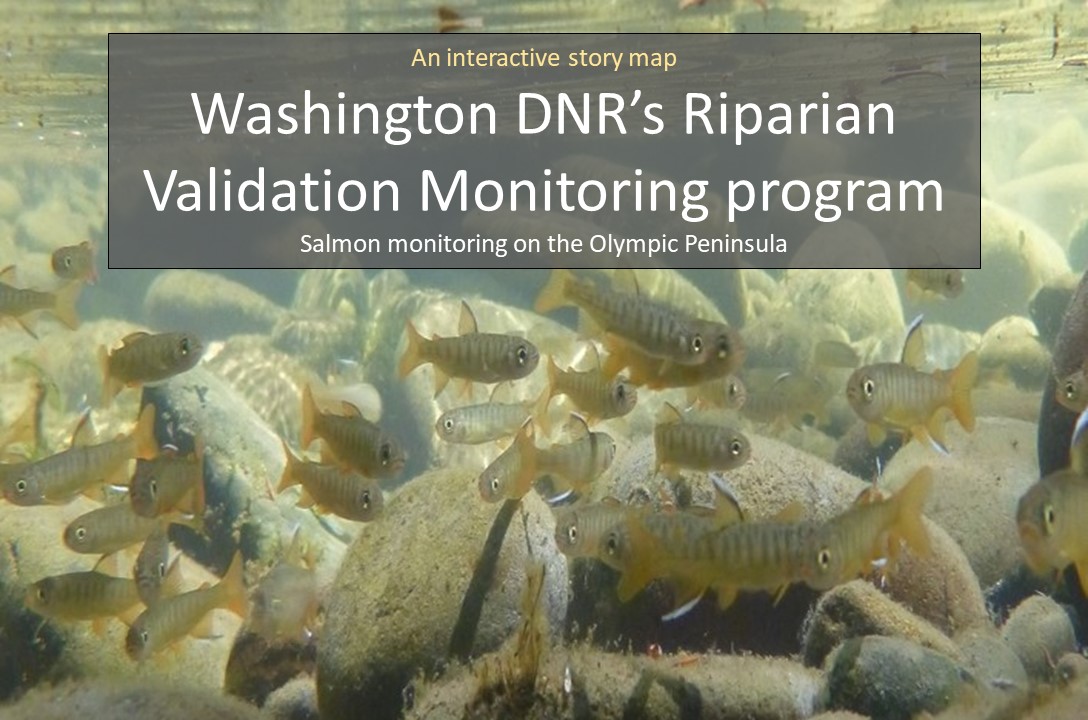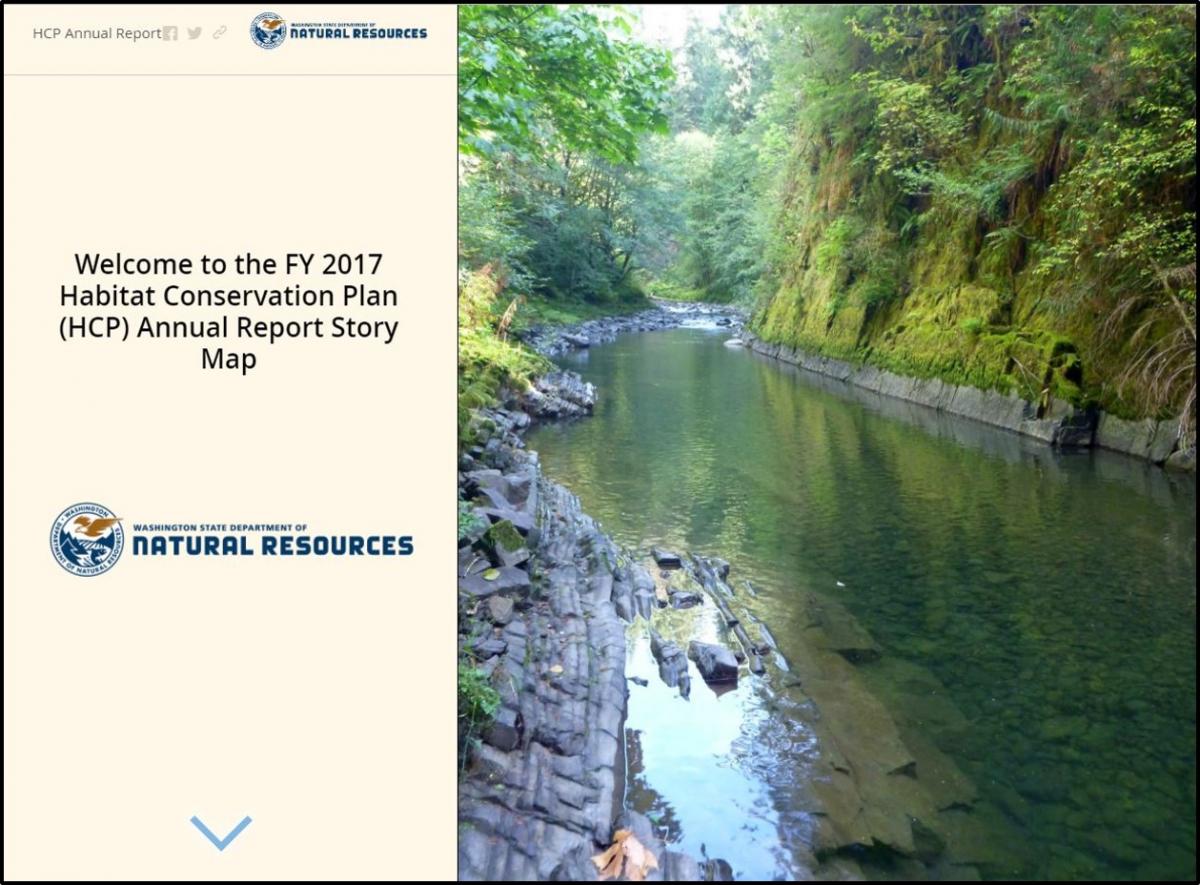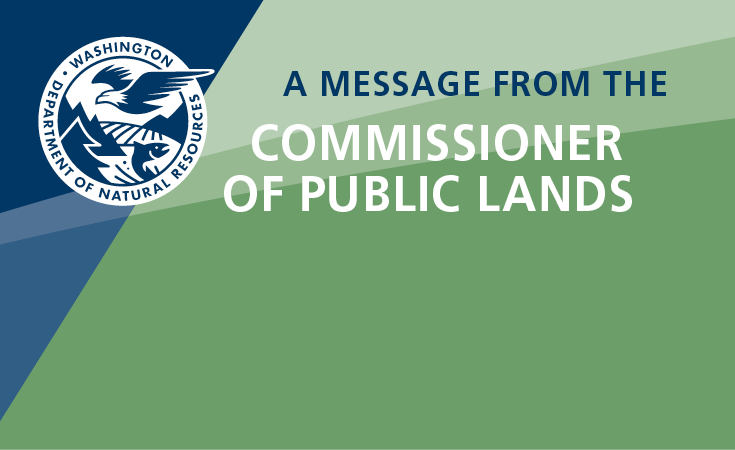Monitoring and Reporting
State Trust Lands Habitat Conservation Plan
The State Trust Lands Habitat Conservation Plan (HCP) directs DNR to continually develop better methods of achieving conservation goals based on new information, and to report its HCP-related activities to the public and to the US Fish and Wildlife Service and National Oceanic and Atmospheric Administration annually. Visit the following links to learn more:
Implementation Monitoring
Also known as compliance monitoring, implementation monitoring determines whether the State Trust Lands Habitat Conservation Plan's conservation strategies are implemented as written.
This project assessed the implementation of the Riparian Forest Restoration Strategy (RFRS) and tracking of riparian restoration treatments within the Land Resource Manager database. Monitoring staff visited 37 riparian restoration treatments in the field to determine if these treatments were implemented following guidance in the RFRS. Additionally, the spatial delineation of 121 riparian restoration treatments were assessed for accuracy using aerial imagery and timber sale documentation.
This project assessed the suitability and effectiveness of using remotely sensed data to evaluate leave tree quantity and proximity, compared leave tree proximity and quantity results from different data sources, summarized leave tree characteristics including blowdown and species diversity, and determined DNR’s level of compliance in meeting the minimum leave tree quantity requirements. Leave tree proximity and quantity results from four remotely sensed data sources were compared with each other and with field data.
Implementation of the Uncommon Habitats Component of the Multispecies Conservation Strategy – Published March 2017
This project assessed implementation of conservation measures afforded to uncommon habitats. Monitoring staff visited 74 uncommon habitat features (including balds, caves, cliffs, and talus fields) associated with 33 timber sales to determine if the HCP conservation objectives for each habitat type were met.
This project assessed implementation of conservation measures afforded to uncommon habitats. Monitoring staff visited 74 uncommon habitat features (including balds, caves, cliffs, and talus fields) associated with 33 timber sales to determine if the HCP conservation objectives for each habitat type were met.
Implementation of the Roads Component of the Riparian Forest Restoration Strategy – Published March 2016
This project reviewed implementation of the roads component of RFRS. Monitoring staff visited 31 road crossings of Type 3 streams in order to determine if the guidance was implemented correctly and if any modification of the guidance could make activities more consistent with the management goal of RFRS.
This project reviewed implementation of the roads component of RFRS. Monitoring staff visited 31 road crossings of Type 3 streams in order to determine if the guidance was implemented correctly and if any modification of the guidance could make activities more consistent with the management goal of RFRS.
Implementation of Northern Spotted Owl Habitat Maintenance Treatments – Published May 2015
Results of a project that looked at the implementation of northern spotted owl habitat maintenance treatments. Monitoring staff visited 11 forest management units from 6 timber sales. At each, a post-harvest stand level Curtis relative density (RD) greater than or equal to 48 was used to assess HCP compliance.
Results of a project that looked at the implementation of northern spotted owl habitat maintenance treatments. Monitoring staff visited 11 forest management units from 6 timber sales. At each, a post-harvest stand level Curtis relative density (RD) greater than or equal to 48 was used to assess HCP compliance.
2013 - Implementation Monitoring Report
Management activities in wetlands and wetland management zones that were completed during fiscal year 2013; and all hardwood conversion and individual conifer release riparian restoration treatments completed prior to August 2013.
Management activities in wetlands and wetland management zones that were completed during fiscal year 2013; and all hardwood conversion and individual conifer release riparian restoration treatments completed prior to August 2013.
2012 Implementation Monitoring Report
Riparian restoration treatments and management of potentially unstable hillslopes.
Riparian restoration treatments and management of potentially unstable hillslopes.
2009-2011 Implementation Monitoring Report
(monitored in the office only). Compliance on timber sales completed in fiscal years 2009, 2010 and 2011 with northern spotted owl strategy, Also roads and rain-on-snow elements of the riparian strategy and reliability of DNR’s Planning and Tracking database.
(monitored in the office only). Compliance on timber sales completed in fiscal years 2009, 2010 and 2011 with northern spotted owl strategy, Also roads and rain-on-snow elements of the riparian strategy and reliability of DNR’s Planning and Tracking database.
2008 Implementation Monitoring Report
Large, structurally unique trees and snags portions of the uncommon habitats strategy and the wetlands portion of the riparian conservation strategy.
Large, structurally unique trees and snags portions of the uncommon habitats strategy and the wetlands portion of the riparian conservation strategy.
2007 Implementation Monitoring Report
Stream typing and buffering portion of the riparian conservation strategy for the Olympic Experimental State Forest. Also uncommon habitats (cliffs, balds, and oak woodlands) in western Washington
Stream typing and buffering portion of the riparian conservation strategy for the Olympic Experimental State Forest. Also uncommon habitats (cliffs, balds, and oak woodlands) in western Washington
2006 Implementation Monitoring Report
Errata Sheet
Stream typing and buffering portion of the riparian conservation strategy for westside HCP planning units.
Errata Sheet
Stream typing and buffering portion of the riparian conservation strategy for westside HCP planning units.
2005 Implementation Monitoring Report
Rain-on-snow and northern spotted owl conservation strategies.
Rain-on-snow and northern spotted owl conservation strategies.
2004 Implementation Monitoring Report
Wetlands; wind buffers (on riparian management zones); and legacy trees (those left following regeneration harvests to provide structure and a seed source). Also cliffs and bald eagles.
Wetlands; wind buffers (on riparian management zones); and legacy trees (those left following regeneration harvests to provide structure and a seed source). Also cliffs and bald eagles.
2003 Implementation Monitoring Report
Northern spotted owl and stream types and buffers (riparian management zones).
Northern spotted owl and stream types and buffers (riparian management zones).
2002 Implementation Monitoring Pilot Project
Applicable conservation strategies in two HCP planning units
Applicable conservation strategies in two HCP planning units
Evaluation of how DNR staff assesses slope stability on timber sales, including consistency and accuracy of unstable slope identification, application of mitigation measures, and post-harvest ground conditions.
Effectiveness Monitoring
What does effectiveness monitoring do?
-
Determines whether implementing conservation strategies results in expected habitat conditions
-
Considers cause-and-effect relationships
-
Is either passive (retrospective studies of existing research; following existing silvicultural prescriptions) or active (designing field experiments; developing prescriptions)
What are the purposes of effectiveness monitoring?
-
Documenting short-term (1-3 years after silvicultural treatment) and long-term changes in habitat conditions. A variety of habitat attributes are measured, such as:
-
Forest stand structure (tree size, density, canopy closure, etc.)
-
Large woody debris
-
Snags
-
What effectiveness monitoring projects is DNR working on?
- Enhancing Spotted Owl Habitat Through Variable Density Thinning
- NSO Habitat Effectiveness Monitoring
- Monitoring of Instream Habitat Conditions and Trends
- Studying Riparian Silviculture Treatment Alternatives
- Monitoring Water Quality on Mill and Abernathy Creeks
Validation Monitoring
What is validation monitoring?
Monitoring to evaluate cause-and-effect relationships between habitat conditions resulting from implementation of the conservation strategies and the animal populations these strategies are intended to benefit.
What validation monitoring projects is DNR working on?
Learn about DNR's Riparian Validation Monitoring Program using this interactive story map.
Note that videos in the story map work best when viewed on a computer. Some videos are replaced with photos when viewed on a mobile device.
Annual Reporting to the Federal Services
As a 'landowner' DNR negotiated its Habitat Conservation Plan with the USDA Fish & Wildlife Service, and NOAA Fisheries Service (Federal Services). The HCP agreement calls for the department to provide annual reports to the US Fish and Wildlife Service and National Oceanic and Atmospheric Administration. These reports cover items such as miles of roads abandoned, activities in designated northern spotted owl habitat, trust land transactions, leases and rights of way, and monitoring and research summaries. As a record of our activities during the fiscal year, these reports allow us to document trends and the factors influencing them. They also highlight our achievements in meeting HCP goals to offset any harm our management activities may cause to an individual (animal, or plant) of a species with protections that promote the long-term health of the species as a whole. This is achieved through habitat conservation, restoration or, in some cases, developing habitat. Hyperlinks in the reports below work best when viewed in Internet Explorer, Chrome, or Firefox.
Fiscal Year 2019
Fiscal Year 2018
Explore highlights from the FY 2018 Annual report using this interactive story map.
Fiscal Year 2018
Explore highlights from the FY 2018 Annual report using this interactive story map.





